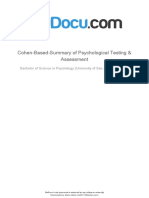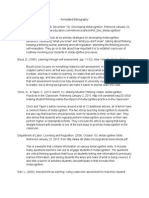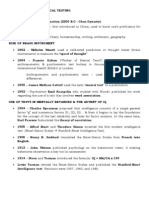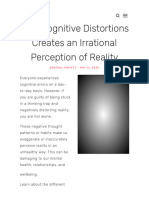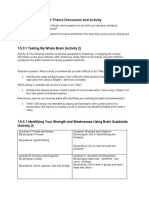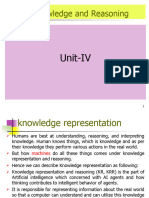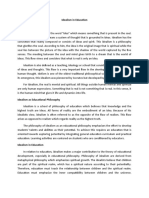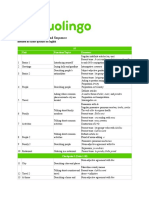BPI
BPI
Uploaded by
Lara Patricia TamsiCopyright:
Available Formats
BPI
BPI
Uploaded by
Lara Patricia TamsiOriginal Description:
Copyright
Available Formats
Share this document
Did you find this document useful?
Is this content inappropriate?
Copyright:
Available Formats
BPI
BPI
Uploaded by
Lara Patricia TamsiCopyright:
Available Formats
Basic Personality Inventory
Introduction:
Administration, Scoring
and Interpretation for
Hand Scoring
Dale Pietrzak, Ed.D.
LPC-MH, CCMHC
BPI Overview
240 Items
Counterbalanced True and False Items for
all but the deviation Scale
Easily hand scored in 10 minutes
Good Response Set detection in computer
scored report
Ages 12 through Adult
Seems OK ...
Hand Scoring
1 key for the 12 main scales
Total number of marked responses for each half
of each scale
1 Balanced desirability scale
Total number of True responses for
inventory
I think I can do that!
Adult Norms
Marital %
Single 16.7
Married 67.6
Widowed 7.2
Divorced 6.8
Age %
19-20 3.6
21-30 26.6
31-40 22.0
41-50 14.0
51-60 15.0
61-65 8.3
66+ 10.5
Region %
N East 30.6
SE & SC 14.8
N Central 28.2
Pac. & Mtn. 26.4
Occupation %
Mang. & Professional 36.4
Sales & Adm. Support33.2
Skilled Workers 12.4
Service Workers 6.6
Semi-Skilled Wrks. 7.2
Unskilled Wrks. 3.9
Adolescent Norms
n = 2210: 880 Males and 1380 Females
Based on pooled samples of 2 Canadian
providences
Stratified Random Sample
Sex, Age, Rural-urban & Social Class
Only sex showed significant differences
Who cares?
Reliability of BPI: Adult
Hypocondrisis .74 .73 .74
Depression .85 .85 .85
Denial .67 .63 .65
Interpersonal Problems .82 .77 .80
Alienation .81 .77 .79
Persecutory Ideas .71 .78 .75
Anxiety .75 .78 .77
Thinking Disorder .64 .71 .68
Impulse Expression .78 .78 .78
Social Introversion .82 .87 .85
Self Depreciation .62 .77 .70
Deviation .70 .69 .70
Test-Retest Stability: 1 Month
Holden Kilduff Median
Internal Consistency: Adult
Hypocondrisis .80 .82
Depression .83 .86
Denial .69 .69
Interpersonal Problems .70 .74
Alienation .63 .75
Persecutory Ideas .74 .81
Anxiety .78 .77
Thinking Disorder .65 .78
Impulse Expression .68 .74
Social Introversion .77 .81
Self Depreciation .61 .82
Deviation .63 .55
Normal
Psychiatric
KR-20 Alpha
Reliability of BPI: Adolescent
KR-20 Internal Consistency
Hypocondrisis .77
Depression .80
Denial .61
Interpersonal Problems .72
Alienation .72
Persecutory Ideas .73
Anxiety .57
Thinking Disorder .72
Impulse Expression .74
Social Introversion .79
Self Depreciation .73
Deviation .66
Why do
I have to
learn
this?
Blah
Blah
Standard Error of Measurement
Hypocondrisis 5.1 4.3
4.8
Depression 3.9 3.9
4.5
Denial 5.9 5.6
6.2
Interpersonal Problems 4.5 5.3
5.3
Alienation 4.6 5.6
5.3
Persecutory Ideas 5.0 4.7
5.2
Anxiety 4.8 4.7
6.6
Thinking Disorder 5.7 5.3
5.3
Impulse Expression 4.7 5.4
5.1
Social Introversion 3.9 4.6
4.6
Self Depreciation 5.5 5.3
5.2
Deviation 5.5 6.4
5.8
Consistency Consistency
Stability Adult Adoles.
Mean: 4.9 4.7 5.3
Basic Interpretation
Uses linear T-scores
70 or higher indicates a clinical elevation
approximately the 97th percentile
60 to 69 has elements of scale
approximately the 85th percentile
50 or less generally has positive aspects of
scale
Interpretation Continued
65-74 minimal to milder symptoms.
75 or more moderate to severe symptoms.
May have normal people score in clinical
ranges.
Need to know history.
Need to be able to abstract more normal
displays to very severe displays for each scale
Clinical judgment is required
BPI Response Set Detection
Balanced Desirability (Adult)
19 or more Fake Good
8 or less Fake Bad
Total Number of True Responses (Adult)
153 or more True response set
77 or less False response set
Denial Scale over 70 with lower scores on other
scales
Denial of Symptoms
BPI Response Set Detection
Deviation over 70 with other scales high
Infrequent symptom pattern
Random raw scores of 10 2 on almost all
scales
Hand scored infrequency and consistency
scales under construction
Admit it !
Content Categories
A. Social Deviation/Inadequate Socialization
- Interpersonal Problems
- Alienation
- Impulse Expression
B. Mood Personal/Emotional Adjustment
- Depression
- Anxiety
- Hypochondriasis
C. Cognitive Functioning
- Thinking Disorder
- Persecutory Ideas
D. Self-Perception & Sociability
- Self Depreciation
- Social Introversion
Correctional
Scales
E. Critical Deviant Behaviors
- Deviation
F. Guardedness
- Denial
Higher Order Factor Scales
Psychiatric Symptomology
Hypochondriasis, Persecutory Ideas, Anxiety,
Thinking Disorder and Deviation
Social Symptomology
Interpersonal Problems, Alienation, Persecutory
Ideas, Impulse Expression and Deviation
Depression
Depression, Self-Depreciation & Social
Introversion
Hypochondriasis
I ntended: Identify those with physical symptoms which are either
caused psychologically, or exaggerated psychologically.
70+
Frequently concerned about being ill. Complains regularly of
peculiar pains or bodily dysfunctions. Discusses such topics
frequently, revealing a preoccupation with such complaints.
60-69
Many with real physical conditions score in this range.
Less than 50
Is without excessive bodily concern or preoccupation with
physical complaints. Absenteeism due to illness is below
average.
Depression
I ntended: To identify those who have the cognitive, affective and
some physical symptoms of depression.
49 or less
reports a usual feeling of confidence, cheerfulness, and
persistence, even when experiencing disappointment. Has an
optimistic attitude about the future.
70+
Is inclined to be down-hearted and show extreme despondency;
considers self to be inadequate; may be listless, remote, and
preoccupied; looks at the future pessimistically.
Denial
I ntended: To identify those who are guarded or denying symptoms.
Less than 50
Accepts feelings as part of self. Is not afraid to discuss unpleasant
topics. Can answer questions about self frankly; avoids impression
management. Shows normal affect. Reasonably insightful.
70+
Lacks insight into feelings and the causes of own behavior. Avoids
unpleasant, exciting or violent topics. relatively unresponsive
emotionally. Questionable validity, especially if clinical scales are
lower than expected.
Interpersonal Problems
I ntended: To identify those who have difficulty getting along
with others. Especially due to irritability and
oppositional styles.
49 or less
Reasonably cooperative. Experiences less than average irritation
from their environment and others. Handles noises, interruptions,
changes in routine, disappointments, others mistakes and
authority reasonably well. Prefers clearly defined rules and
regulations; able to handle criticism.
70+
Is often extremely annoyed by little inconveniences, frustrations, or
disappointments; uncooperative, disobedient, resistant to others,
and reacts against discipline, rules and criticism.
Alienation
I ntended: To identify those with asocial, or personalized standards
of right and wrong.
Less than 50
Ordinarily displays socially acceptable ethical attitudes and is
socially responsible. Reports feeling a sense of obligation
toward society and its laws (conscience).
70+
Expresses attitudes markedly different from common social codes;
is prone to depart from the truth and behave in an unethical/illegal
and untrustworthy manner; feels little or no guilt about behavior.
Persecutory Ideas
I ntended: To identify those who have paranoid ideation.
49 or less
Trust others and does not feel threatened. Accepts responsibility
for the events in life and does not attribute maliciousness to others.
70+
Believes that certain people are hostile and are trying to make
life difficult and/or unpleasant. Inclined to brood. Distrusts others.
Anxiety
I ntended: To identify those who have the cognitive and
affective symptoms of anxiety. Emotional reactivity.
Less than 50
Remains calm, unruffled and not worried even when confronted
by unexpected occurrences. Takes things as they come without
fear or apprehension. Maintains personal control even in crisis
situations.
70+
Easily scared and worrisome. Little things, even an idea, can
cause a frenzy of anxiety. Afraid of physical or interpersonal
danger.
Thinking Disorder
I ntended: To identify those with problems with reality testing
and difficulties with distractibility and/or concentration.
49 or less
Has no difficulty with reality testing. Has no difficulty
distinguishing daydreams from reality. Is able to concentrate and
maintain sensible conversations.
70+
Is markedly confused, distractible and cognitively disorganized.
cannot remember simple things from day to day. reports feeling
that life is dream-like, and that there is a marked difference
between self and others (sees self as different from others-odd).
Impulse Expression
I ntended: To identify impulsive, hedonistic minded responses.
Sensation seeking and risky behaviors.
Less than 50
Appears to be even-tempered and level headed; considers the
future and consequences before acting; generally has the
patience to cope with lengthy and tedious tasks. Persistence.
70+
Lacks the ability to think beyond the present and consider the
consequences of action; is prone to undertake risky and
reckless actions; inclined to behave irresponsibly; finds routine
tasks boring.
Social Introversion
I ntended: To identify people who avoid others either due to
disinterest, fear or withdrawal.
49 or less
Enjoys company and being with others. Likes to talk and knows
many people. Spends time with others, seeks others out.
70+
Avoids people generally. Has few friends, or is withdrawing from
friends. Says little to others, even friends. Seems to be
uncomfortable when around others. Prefers to keep to self or
asocial activities.
Self Depreciation
Less than 50
Manifests a high degree or self-assurance in dealing with others.
Not afraid to meet strangers; speaks with confidence about a
variety of topics; believes in own abilities and that he/she can
accomplish things.
I ntended: To identify those who are negative and/or self-
depreciating. Poor self-esteem.
70+
Degrades self as being worthless, unpleasant, and undeserving.
Generally expresses a low opinion of self and refuses credit for
any accomplishment.
Deviation
I ntended: To identify unusual response styles and behavior
patterns which are very pathological.
49 or less
Generally shows behavior patterns similar to those of a majority
of people. Tends to be free from unusual symptoms and modes
of thought.
70+
Displays behavior patterns very different from most peoples.
admits to unusual and pathological characteristics. If elevated with
most other scales watch for fake bad.
Empirical Scale Combinations: Adults
Hallucinations:
Thinking Disorder with Persecutory Ideas
(lower depression)
Delusions:
Persecutory Ideas with Alienation and Thinking
Disorders (lower depression)
Mania:
Impulse Expression with Denial &
Hypochondrias
E-Scale Combinations Cont
Depression:
Depression with Self Depreciation and Anxiety
Anxiety:
Anxiety with Depression and Hypochondrias
(lower Alienation)
Somatic Complaints:
Depression, Hypochondrias and self-
depreciation with Anxiety and Persecutory
Ideas
E-Scale Combinations Cont
Insomnia
Social Introversion with Self Depreciation and
lower Alienation
Anorexia
Lower Alienation and Interpersonal Problems
with lower Thinking Disorder and Lower
Persecutory Ideas
E-Scale Combinations Cont
Assaultive Behavior
Interpersonal Problems with
Alienation and Persecutory Ideas
Alcoholism (In Treatment)
Moderate elevations on Interpersonal Problems,
Hypochondrias, depression, Alienation, Social
Introversion (Lower Denial)
E-Scale Combinations Cont
Drug Abuse (In Treatment)
Alienation, Interpersonal Problems and
Deviation (Impulse Expression) with Lower
Denial
Suicidal Behavior
Depression with Deviation, Self depreciation,
Anxiety and Social Introversion
Neuroticism
Hypochondrias, Anxiety, Social Introversion
Empirical Patterns: Adolescents
Pattern 1: Mental Health Difficulties
Depression, Anxiety, Self depreciation and
Deviation
Higher the elevation the worse adjusted
Pattern 2: I nterpersonal Maladjustment
Interpersonal Problems, Persecutory Ideas, and
Impulse Expression
Rebellious and anti-establishment (More
oppositional)
Adolescent Patterns Continued
Pattern 3: Antisocial Delinquency
Alienation, Interpersonal Problems and Impulse
Expression
Pattern 4: Defensive Denial (offenders)
Denial other normal to low
Females Persecutory Ideas common-indicates
feeling unfairly treated
Leave me alone!
Adolescent Patterns Continued
Pattern 5: Performance Anxiety resulting
in Somatic Complaints (Neurotic)
Hypochondrias, Anxiety, and Social
Introversion
Pattern 6: High risk Rebelliousness
Depression, Anxiety, Self Depreciation,
Interpersonal Problems, Alienation, Impulse
Expression, and Deviation
Scale Defense Mechanisms
Hypochondrias: Repression & Denial
Depression: Rationalization
Denial: Denial & Repression
I nterpersonal Problems: Projection,
Blocking
Alienation: Projection, Blocking
Persecutory I deas: Projection and other
blame
Scale Defense Mechanisms
Anxiety: Rationalization
Thinking Disorder: Distancing,
Disassociation, Blocking
I mpulse Expression: Ignoring,
Rationalization
Social I ntroversion: Withdrawal, Escape
Self-Depreciation: Self-Blame, Giving up
Other Scale Interactions
Interpret how the various scales interact
with each other
No established guidelines: Intuitive Clinical
Judgment
Interpretation Process
Investigate Validity and Distortion
Factor Scale Interpretation
Content Category Interpretation
Empirical Patterns
Specific Scale Interpretations & Scale
Interactions
Hum ...
You might also like
- Basic Personality InventoryDocument7 pagesBasic Personality InventoryAlthea Coronel89% (9)
- FWVS Questionnaire PDFDocument13 pagesFWVS Questionnaire PDFFloyd Ferdusson MejiasNo ratings yet
- Sack Sentence Completion Scoring and InterpretationDocument3 pagesSack Sentence Completion Scoring and Interpretationmarialouisalexandriaco100% (2)
- TOS Outline PsychAssess FinalDocument42 pagesTOS Outline PsychAssess FinalJeann RegachoNo ratings yet
- SACHS Sentence Completion Test Procedure and AdministrationDocument16 pagesSACHS Sentence Completion Test Procedure and AdministrationBeth Aquino Dm100% (4)
- Cohen Based Summary of Psychological Testing AssessmentDocument31 pagesCohen Based Summary of Psychological Testing AssessmentAlok Singh100% (2)
- Basic Personality Inventory (Bpi)Document14 pagesBasic Personality Inventory (Bpi)Roxanne Forbes100% (1)
- Human Figure Drawing TestDocument13 pagesHuman Figure Drawing TestJean paul Geronimo100% (1)
- Bender Gestalt Test InterpretationDocument2 pagesBender Gestalt Test InterpretationJayla Marie Galang100% (3)
- Basic Personality Inventory: Douglas N. Jackson, PH.DDocument18 pagesBasic Personality Inventory: Douglas N. Jackson, PH.Djaena maegan alarma100% (1)
- Assessment Profile ReportDocument1 pageAssessment Profile ReportChai Aries50% (4)
- Filipino Made ExamsDocument6 pagesFilipino Made ExamsJesse Ebreo100% (2)
- Basic Personality Inventory Scale DescriptionsDocument3 pagesBasic Personality Inventory Scale Descriptionslouie roderos100% (1)
- TKT Module 1 Practice PaperDocument15 pagesTKT Module 1 Practice PaperS Chinthareddy100% (2)
- Guilford-Zimmerman Temperament SurveyDocument23 pagesGuilford-Zimmerman Temperament SurveyKim Rose Borres100% (1)
- House Tree Person (Interpretation)Document3 pagesHouse Tree Person (Interpretation)xenierj100% (2)
- Dan Ariely - The Upside of IrrationalityDocument11 pagesDan Ariely - The Upside of IrrationalityJasvinder TanejaNo ratings yet
- BPI InterpretationDocument40 pagesBPI Interpretationportiadeportia100% (3)
- Basic Personality Inventory (BPI) : by Douglas N. Jackson, PH.DDocument27 pagesBasic Personality Inventory (BPI) : by Douglas N. Jackson, PH.Dgerielle mayo100% (2)
- PPP PsychDocument36 pagesPPP Psychbadass bitxch50% (2)
- PSYCHOLOGICAL ASSESSMENT Reviewer PDFDocument33 pagesPSYCHOLOGICAL ASSESSMENT Reviewer PDFSamantha Guevara100% (1)
- PPP and Mapa NG LoobDocument37 pagesPPP and Mapa NG LoobShye Uy100% (1)
- Psych Report - SSCTDocument5 pagesPsych Report - SSCTLiza Obtial BrionesNo ratings yet
- 000AA - Drills - Psychological Assessment - Part 1 - Applications - QADocument54 pages000AA - Drills - Psychological Assessment - Part 1 - Applications - QAFriendces Dia Diaman75% (4)
- Basic Personality InventoryDocument8 pagesBasic Personality InventoryElisa Mae Oranza Gura100% (2)
- Interpret PresentationDocument16 pagesInterpret PresentationJaypee EchanoNo ratings yet
- Handouts - Panukat NG Ugali at PagkataoDocument14 pagesHandouts - Panukat NG Ugali at PagkataoShara Tumambing MA Psy33% (3)
- Abpsych Barlow Reviewer 1 Abpsych Barlow Reviewer 1Document30 pagesAbpsych Barlow Reviewer 1 Abpsych Barlow Reviewer 1Sharemax Holdings, Inc.100% (1)
- Sach Sentence Completion Test InterpretationDocument4 pagesSach Sentence Completion Test Interpretationrupal arora67% (3)
- Assessment Test CompilationDocument5 pagesAssessment Test CompilationGian LynardNo ratings yet
- Warder A K Introduction To Pali 489p PDFDocument490 pagesWarder A K Introduction To Pali 489p PDFNathalie100% (2)
- Measuring Service Quality of Bigbasket Using SERVQUALDocument7 pagesMeasuring Service Quality of Bigbasket Using SERVQUALkapil tomarNo ratings yet
- Annotated BibliographyDocument3 pagesAnnotated Bibliographyapi-283949676No ratings yet
- Informed Consent FormDocument2 pagesInformed Consent FormKlein Xavier Boiser0% (1)
- ILesson 6 Ndigenous Filipino Psychological TestsDocument30 pagesILesson 6 Ndigenous Filipino Psychological TestsNina Alliah J BayangatNo ratings yet
- Sacks SSCTDocument25 pagesSacks SSCTEmer Son80% (5)
- SSCT OverviewDocument5 pagesSSCT OverviewNicko Espineda VargasNo ratings yet
- (Cohen) Psych Assessment ReviewerDocument63 pages(Cohen) Psych Assessment Reviewercoby & whiteyNo ratings yet
- Abnormal Psychology Summary (Chapter 1 - 2)Document29 pagesAbnormal Psychology Summary (Chapter 1 - 2)Louise Alenah LabragueNo ratings yet
- Ethical-Issues in Psychological Testing Chap3 Part1Document20 pagesEthical-Issues in Psychological Testing Chap3 Part1Ahmad Farooq100% (1)
- Ethics in Psychological Research-1Document43 pagesEthics in Psychological Research-1Paul Morakinyo100% (2)
- Reviewer - Panukat NG Pagkataong Pilipino PDFDocument5 pagesReviewer - Panukat NG Pagkataong Pilipino PDFEnyaMaeFabrigarNo ratings yet
- Reviewer in ClinicalDocument5 pagesReviewer in Clinicalmovieplaylist001100% (1)
- Summary of SikoPilDocument9 pagesSummary of SikoPilKyra RMNo ratings yet
- TOS Outline AbPsy FinalDocument40 pagesTOS Outline AbPsy FinalJeann RegachoNo ratings yet
- The Top Mental Illness in The Philippines Is Also The Least UnderstoodDocument2 pagesThe Top Mental Illness in The Philippines Is Also The Least UnderstoodRissa CoronelNo ratings yet
- Psychological Testing 1Document17 pagesPsychological Testing 1Renee Rose Masicampo100% (6)
- Notes On Filipino PsychologyDocument3 pagesNotes On Filipino PsychologyMicah Europa100% (2)
- The Hand TestDocument2 pagesThe Hand TestRhea CaasiNo ratings yet
- Filipino Psychology ReviewerDocument15 pagesFilipino Psychology ReviewerGraceLy Mateo100% (1)
- Feist Theories of Personality Chapter 1Document2 pagesFeist Theories of Personality Chapter 1Rashia LubuguinNo ratings yet
- Psych Assessment Chapter 12Document5 pagesPsych Assessment Chapter 12Marjorie VillarosaNo ratings yet
- IO Chapter 1-5 PDFDocument10 pagesIO Chapter 1-5 PDFJasmin ValloNo ratings yet
- Updated SSCT ReportDocument40 pagesUpdated SSCT ReportMAYLENE CUENCONo ratings yet
- Compilation of Psych TestsDocument6 pagesCompilation of Psych TestsRaul MartinNo ratings yet
- Psychological Test Report I. Personal DataDocument7 pagesPsychological Test Report I. Personal DataJun Reyes RamirezNo ratings yet
- Dap ManualDocument31 pagesDap Manualnesuma100% (1)
- Document 1 - PurdueDocument5 pagesDocument 1 - PurdueJunaisah Hadji Omar100% (1)
- Sack's Sentence Completion Test SSCT Interpretation: Family Area MotherDocument4 pagesSack's Sentence Completion Test SSCT Interpretation: Family Area MotherAngel100% (1)
- 5 Indigenous Personality Test ScalesDocument2 pages5 Indigenous Personality Test ScalesRodjie Jan Matillano100% (1)
- PSYCHOLOGICAL ReportDocument11 pagesPSYCHOLOGICAL ReportPigeon Sport TV71% (7)
- Devpsy PrelimsDocument17 pagesDevpsy PrelimsCarmina Villaruel100% (1)
- Basic Personality Inventory: Administration, Scoring and Interpretation For Hand ScoringDocument40 pagesBasic Personality Inventory: Administration, Scoring and Interpretation For Hand ScoringLutfi DinayantiNo ratings yet
- 15 Common Cognitive Distortions - Mind My PeelingsDocument30 pages15 Common Cognitive Distortions - Mind My PeelingsSamrandNo ratings yet
- 1.mental Health PromotionDocument59 pages1.mental Health PromotionjhurNo ratings yet
- Expertise in TeachingDocument22 pagesExpertise in Teachingdanielonyeneke148No ratings yet
- DLL Cpar Week 1Document5 pagesDLL Cpar Week 1rassel ann agananNo ratings yet
- Mathematical LogicDocument15 pagesMathematical LogicEfean KimNo ratings yet
- Wolff-Michael Roth Auth. On Meaning and Mental Representation A Pragmatic ApproachDocument227 pagesWolff-Michael Roth Auth. On Meaning and Mental Representation A Pragmatic Approachtomil.hoNo ratings yet
- Theory U Exec SummaryDocument21 pagesTheory U Exec SummaryJohn Michael100% (10)
- Tony Hawk LessonDocument4 pagesTony Hawk Lessonapi-241206562No ratings yet
- Teaching As A MissionDocument11 pagesTeaching As A MissionMarie ShaneNo ratings yet
- Unit 2. The Phases of A CompilerDocument23 pagesUnit 2. The Phases of A CompilerNguyễn Duy TiếnNo ratings yet
- 1.5.2 The Whole Brain Theory Discussion and ActivityDocument7 pages1.5.2 The Whole Brain Theory Discussion and ActivityJohn PaulNo ratings yet
- Entity-Relationship Diagrams (ERD)Document10 pagesEntity-Relationship Diagrams (ERD)niroshanieNo ratings yet
- Knowledge and Reasoning: Unit-IVDocument31 pagesKnowledge and Reasoning: Unit-IVasarvigaNo ratings yet
- Question: Students Should Get Involved in Community Activities.' Do You Agree?Document1 pageQuestion: Students Should Get Involved in Community Activities.' Do You Agree?Are-in Liyana100% (2)
- Speech: Types of SpeechesDocument5 pagesSpeech: Types of SpeechesJane Sagutaon100% (1)
- Student RecruitmentDocument12 pagesStudent RecruitmentyuanknNo ratings yet
- The Meta-Analysis of Neuro-Marketing StudiesDocument14 pagesThe Meta-Analysis of Neuro-Marketing StudiesDaniel GardanNo ratings yet
- Statement of PurposeDocument3 pagesStatement of PurposeShubham AggarwalNo ratings yet
- 1 s2.0 S2214782919300260 MainDocument9 pages1 s2.0 S2214782919300260 MainHesty YuliasariNo ratings yet
- Idealism in EducationDocument3 pagesIdealism in EducationAmir SubhaniNo ratings yet
- Duolingo French Scope and SequenceDocument6 pagesDuolingo French Scope and SequenceJosephine RoperNo ratings yet
- I. LayuninDocument8 pagesI. LayuninHelen NavalesNo ratings yet
- Heal Your MindDocument96 pagesHeal Your Mindabhilash100% (3)
- VVAA - Malleability of Spatial Skills Meta AnalysisDocument51 pagesVVAA - Malleability of Spatial Skills Meta AnalysisJesus Jimenez100% (1)
- The Implications of Self-DirectedDocument16 pagesThe Implications of Self-Directedrose elynaNo ratings yet
- Lesson Plan Sample: High School EnglishDocument3 pagesLesson Plan Sample: High School EnglishAndrew CarrollNo ratings yet
- The Creative Process GhiselinDocument18 pagesThe Creative Process Ghiselinzac de la Peña100% (1)





